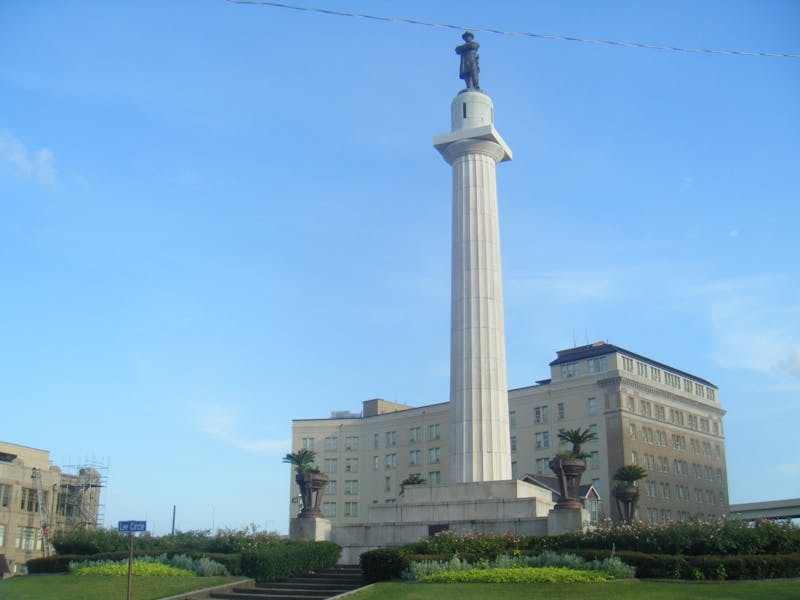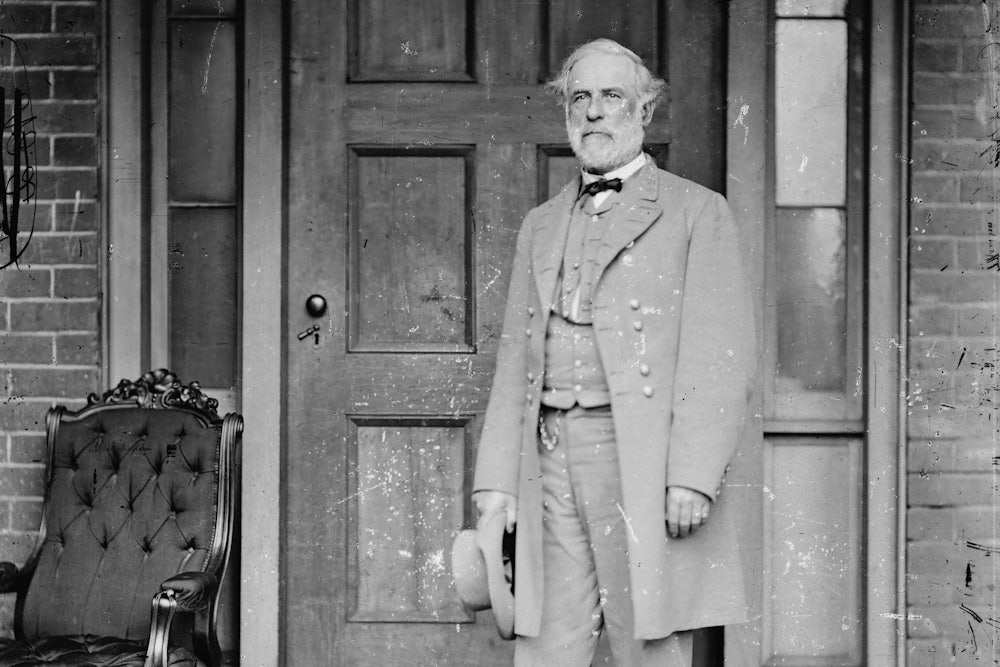On February 22, 1884, thousands of citizens as well as distinguished guests—senators, Supreme Court justices, French and German consuls—attended the unveiling of the monument of Robert E. Lee in New Orleans. Mayor William Behan, who served under Lee in the Confederate Army, proclaimed that the general’s “deeds are his monument, and they will survive and continue in remembrance long after this marble shall have crumbled into dust.”
This past December, at Mayor Mitch Landrieu’s urging, the city council voted 6-1 to have Lee taken down from his perch atop a sixty-foot-tall Doric column, and to also remove monuments to Confederate President Jefferson Davis, General P. G. T. Beauregard, and the “Battle of Liberty Place,” an 1874 insurrection by a white supremacist group. The measure is part of a broader debate, prompted by swelling racial tension, over monuments to Confederate leaders and other white men who promoted racist policies, including John C. Calhoun at Yale, Cecil Rhodes at Oxford and the University of Cape Town, and Woodrow Wilson at Princeton.
In the battle over the legacy of these men, opposing sides have mined the historical record. In New Orleans, those who want Lee taken down say his memory could never be disentangled from the “long years of bondage for black people brought here against their will,” according to an editorial in the Times Picayune. This camp has highlighted Lee’s tenuous connection with New Orleans, his slave-owning, and his views on the institution of slavery (Lee once wrote of blacks, “The painful discipline they are undergoing, is necessary for their instruction as a race…”). Among those who oppose taking Lee down, which includes former Governor Bobby Jindal, some venerate Lee’s legacy while others simply want to preserve the city’s historical landscape.
Amid these recent clashes, though, essential questions have been neglected: What is, or should be, the purpose of public monuments? Should they reflect contemporary values, or should they remind us of our past, however painful it might be? By purging historical monuments in the name of contemporary values, we risk effacing the grievous errors that continue to inform the present. Yet, by preserving them, we also potentially legitimate the legacy of white supremacy. Perhaps there is a third way: one that allows us to preserve history, and in turn monuments, while also activating them in the fight against racial injustice.
In the nineteenth century, figurative sculpture was the
reigning form of monuments in the West. Reaching back to Greco-Roman
conventions, triumphal columns and bronzes consecrated the deeds of heroic
figures and were often used by regimes in power (and still are today) to
project their values. For Confederate loyalists embittered by the loss of the
Civil War, the statue of Robert E. Lee in New Orleans was part of a concerted
effort to recast the city in the image of the Confederacy: The statue of Lee
was erected in 1884, and from 1850 to 1890 the city’s demographics changed rapidly,
as the percentage of whites spiked
from 37 to 66 percent.

New Orleans was “a reluctant secessionist city” that became “more Confederate in its identity during and after Reconstruction,” according to Lawrence Powell, a history professor at Tulane University. The statue of Lee, Powell told me, served “to reaffirm white supremacy.” Walter Johnson, a Harvard historian who has written extensively about the history of slavery in New Orleans, called the statue “a gesture of white power over the city” and a way for Confederates to announce they could constitute the “metropolitan space as descended from and defined by the history of the Confederacy.” This was part of a broader campaign to honor the Lost Cause by redefining public spaces in New Orleans. Congo Square, where slaves used to gather on Sundays to socialize, trade, and play music, was renamed Beauregard Square in 1893 (its original name wasn’t restored until 2011).
Some monuments change in more than name: The statue of Napoleon atop the Vendôme Column in Paris went through three iterations in the nineteenth century to accord with the whims of successive regimes. And all monuments change in meaning, as political values, aesthetic tastes, and historical interpretations shift over time. After falling out of notice for years, some monuments re-emerge in moments of crisis as a clarion call for a contemporary cause. The Robert Gould Shaw Memorial in Boston, a bronze relief by August Saint-Gaudens installed in 1884, shows Shaw leading a regiment of black soldiers during the Civil War. The sculpture was in poor shape for decades until the city’s busing crisis in the 1970s, when civic leaders restored it to demonstrate a commitment to mending racial tension.
In New Orleans, the statue of Lee was little mentioned in recent years. But after the church shooting in Charleston last summer ignited a national debate about the Confederate flag, local activists pushed for the removal of Confederate symbols throughout the city. In June, Mayor Landrieu issued a statement saying, “Prominent locations in our city, such as Lee Circle, ought to reflect the unity, diversity, culture and the wonderful things that bring us together rather than something in our history that has separated us.”
Landrieu’s support for monuments that represent our contemporary commitments to diversity and unity seems noble. But purging monuments that fail to commemorate “the wonderful things that bring us together” risks gutting public and private spaces of their capacity to prompt us to grapple with the past. And if robust democracies seek to respect and encourage a diversity of views, what might they lose by submitting all historical monuments to a single strain of dominant political ideology? All that is pluralistic or diverse about the collection of views represented across the landscape could give way to a homogenous political terrain, one emptied of the differences that stimulate productive debate about our fraught history.
Many in the black community, from the students at Yale to Wynton
Marsalis, the New Orleans–based jazz musician, have posed compelling challenges
to this position. They have argued, importantly, that the removal of these
monuments would create an environment more conducive to the inclusion and
safety of members of marginalized communities. In an op-ed,
Marsalis wrote, “I have never felt compelled to tell anyone who was not from
New Orleans about the true racism that I experienced growing up here.” He
argues that Lee Circle should be transformed into “an inviting space,” not one
that displays the monument of a “general who fought against our country,
against freedom.”
But some major black intellectuals today suggest—though not explicitly—that there might be value in preserving visible traces of racial prejudice. Ta-Nehisi Coates and the law professor Michelle Alexander, among others, have pointed to legal scholars and sociologists who believe that “colorblind” policies and laws are responsible for not only perpetuating racial discrimination under the guise of putatively non-discriminatory language—in domains of housing, employment, policing, incarceration, and jury selection, for instance—but in making it more difficult to identify explicit instances of racism. In The New Jim Crow, Alexander argues that “it is no longer socially permissible to use race, explicitly, as a justification for discrimination, exclusion, and social contempt.” Consequentially, evidence of racial discrimination, she claims, is “the very evidence unavailable in the era of colorblindness.” In cities with large and disadvantaged black populations, such as New Orleans and Baltimore (currently in the process of removing its own Confederate monuments), it would seem imperative, then, to have monuments that represent America’s history of racial discrimination: providing a counter-narrative to the myth of post-racialism and forcing the public to confront the enduring effects of our dark past.
A pledge to reckon with this past would require that we remain committed to learning from, in Landrieu’s words, the “history that has separated us.” To dismount Lee is to cut off one head of the Hydra. Instead of ushering in a new, more progressive era, replacing monuments and names with politically palatable alternatives is to expunge the traces of a history whose ruinous effects still course through our democracy.
This is not to say that we should necessarily keep all monuments. Rather, if the statue of Lee is to be removed, perhaps it should be replaced with a monument commemorating the more than 100,000 slaves sold between 1804 and 1862 in New Orleans. And if the statue of Rhodes is to be preserved at Oxford (as Oriel College recently decided), new monuments and plaques that reject racial prejudice or provide alternative histories should be commissioned.
The statue of Lee, like many monuments, does not simply recall the historical figure but reminds us of the unjust conditions from which it came. We desperately need our monuments to summon that side of history in the struggle against racial injustice today.
